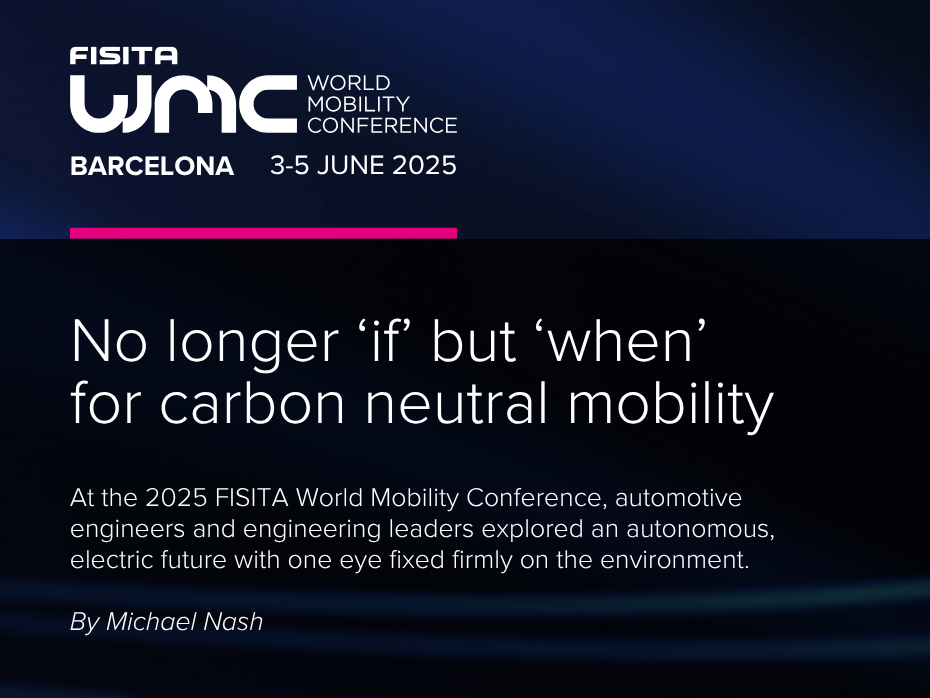It’s no longer a question of “if”, but “when”—and the vision of carbon-neutral mobility that is both affordable and convenient is one shared by the entire automotive industry. In early June, many of the world’s leading automotive and mobility engineers gathered in Barcelona, Spain for the 2025 FISITA World Mobility Conference. But the work on “when-not-if” is far from done, and the event explored the many numerous looming challenges that must be addressed to ensure significant progress is made.
These challenges were laid bare and unpicked during a packed agenda of compelling panel discussions and in-depth technical keynote presentations, while the plenary sessions offered broader oversight from influential figures in the industry. A particular highlight came as José Muñoz, President and Chief Executive Officer of Hyundai Motor Company, stepped up to the stage and delivered the company’s plan to lead a positive change for future mobility with a clear ambition to become carbon neutral.
It’s no longer a question of “if”, but “when”—and the vision of carbon-neutral mobility that is both affordable and convenient is one shared by the entire automotive industry
Touching on a myriad of different topics from manufacturing capabilities to fuel cell electric vehicle (FCEV) adoption, Muñoz set the ball rolling for the event, voicing his confidence in his peers and fellow industry experts to execute the shared vision. It was evident that all other parties present are aligned and ready to push ahead to make clean mobility a reality.
On-going battery electric vehicle (BEV) development and adoption were two of the most pressing themes throughout the three-day event. Data presented by keynote speaker Apostolos Petropoulos of the International Energy Association (IEA) suggests that the global BEV fleet will quadruple by 2030, although this will likely be hindered by the recent tariff wars and possible fluctuation in energy prices.
However, pushing BEVs out to the market will not be enough. Carmakers and suppliers will need a comprehensive global strategy to lower emissions and meet environmental targets. Sustainability and the circular economy, therefore, are no longer buzzwords but blueprints for operation within the automotive industry. And with the BEV market set to grow substantially, one of the primary areas of concern is ensuring a second life or recyclability of lithium-ion batteries. Engineers can only do so much here, and need help from their colleagues in the design department to ensure batteries can be part of the circular economy.
In terms of electrification, all eyes are on new players from China, many of which have cracked the formula for delivering new vehicle programmes on considerably shorter development cycles than the industry has traditionally known. Their imminent expansion in Europe, the Americas, and Asia could send shockwaves throughout the industry, the impact of which is currently unknown. Keynotes and panel discussions included experts from Xiaomi EV, Geely, and Chery—all companies with their sights set on Europe.
Recent language around artificial intelligence (AI) suggests a growing concern among the general public, with many questioning its implications for job security and the long-term future of certain roles.
The likely disruption that will be caused by the deployment of autonomous vehicles (AVs) is being carefully considered, and while much of the technology is ready to go, companies are still tied up in discussions with regulators, while simultaneously balancing shareholder enthusiasm with the need for viable business cases
At WMC 2025, speakers and delegates approached AI with cautious excitement about its potential opportunities and the technological developments it can enable, many of which could result in tangible improvements to people’s lives. With near-endless use case potential, AI could permeate nearly every aspect of the automotive industry, from supply chain management through to optimised user experience, enhanced autonomous driving systems, and even the management of end-of-life vehicle recycling and material handling.
Finally, the likely disruption that will be caused by the deployment of autonomous vehicles (AVs) is being carefully considered, and while much of the technology is ready to go, companies are still tied up in discussions with regulators, while simultaneously balancing shareholder enthusiasm with the need for viable business cases for AV deployment.
The industry is clearly on the precipice of a significant evolution, but the autonomous, electric future of mobility must go hand-in-hand with sustainability efforts. After all—as we heard more than once at the event—there is only one planet Earth.
Michael Nash is an independent automotive industry writer and FISITA contributor
